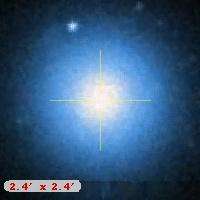NGC 1379
NGC 1379 is a low-luminosity elliptical galaxy in southern constellation Fornax. It was discovered by William Herschel on December 25, 1835.
| NGC 1379 | |
|---|---|
 Optical image of NGC 1379 | |
| Observation data (J2000 epoch) | |
| Constellation | Fornax |
| Right ascension | 03h 36.38m[1] |
| Declination | −35° 26′[1] |
| Redshift | 1324 ± 2 km/s |
| Distance | 18.4 megaparsecs (60 Mly) |
| Apparent magnitude (V) | 10.9[1] |
| Characteristics | |
| Type | E0[1] |
| Apparent size (V) | 2.6′ × 2.5′[1] (50 000 light-years in diameter) |
| Notable features | low-luminosity elliptical galaxy |
| Other designations | |
| ESO 358-27, MCG -6-9-1, PGC 13299 | |
At a distance of 60 million light-years, it is one of the closer members of Fornax Cluster. It is a member of Fornax Cluster, and it is located about 24' from central galaxy, NGC 1399, as twice as NGC 1387, the galaxy next to the NGC 1379. NGC 1387 is also the closest galaxy to this, and it is in foreground from NGC 1379. Both are located in central part of the Fornax Cluster.
NGC 1379 has a Hubble classification of E0, which indicates it is no flattened galaxy. It is also an early-type galaxy, like most other elliptical galaxies in the Fornax Cluster. Its size on night sky is 2.6' x 2.5' which is, combined with the estimated distance, proportional to real size of 50,000 light-years.
Despite their name, early-type galaxies are much older than spiral galaxies, and mostly comprise old, red-colored stars. Very little star formation occurs in these galaxies; the lack of star formation in elliptical galaxies appears to start at the center and then slowly propagates outward.[2]
It is rich with globular cluster, with an estimated number of cluster of 406 ± 81. There are blue and red globular clusters, althrough red globulars are more populous than blue ones. This trend is also seen in NGC 1374, and in NGC 1387, which have only small fraction of blue globular clusters. This galaxy has most equal number of red and blue. This globular clusters, like globulars in NGC 1374 and NGC 1387, didn't show any evidences of multiple populations.[3]
References
- Dunlop, Storm (2005). Atlas of the Night Sky. Collins. ISBN 978-0-00-717223-8.
- Howell, Elizabeth (2015). "Colossal Ancient Galaxies Die from the Inside Out". space.com. Retrieved 5 March 2017.
- Bassino, Lilia P.; Richtler, Tom; Dirsch, Boris (2006). "Globular cluster systems in low-luminosity early-type galaxies near the Fornax cluster centre". Monthly Notices of the Royal Astronomical Society. 367 (1): 156–168. arXiv:astro-ph/0511770. Bibcode:2006MNRAS.367..156B. doi:10.1111/j.1365-2966.2005.09919.x.
External links
